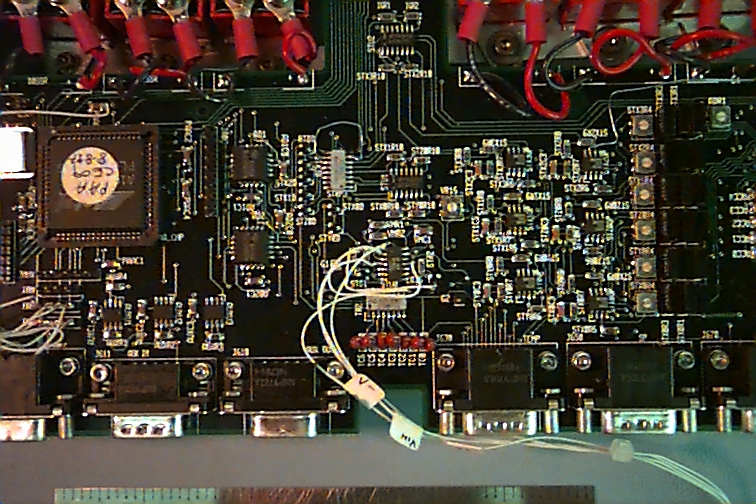
Here's All the fancy stuff. The large black square in the upper left controlled everything. It is a type of IC known as an FPGA or Field Programmable Gate Array - Just a big phrase for a programmable chip. Although it is programable it is not nearly as sophisticated as a computer chip. Most FPGAs have several hundred to a few thousand flip flops or registers, while the computer chips have hundreds of thousands to billions or more.
The 2 black squares to the right of the FPGA are ADCs or Analog to Digital Converters. They read a voltage level and convert it to a digital (binary) number, when ever the controller (FPGA) tells them to. Each one of these ADCs can be hooked up to about 10 different analog channels or voltages. The 7 red dots at the bottom center are capacitors, which are used for a variety of things. In this case, they are being used to filter out noise (unwanted voltage and current spikes) which can cause inaccurate sensor readings.
At the very bottom, you can just make out the top edge of yet another 6" ruler.
Above (as well as to the right) of the capacitors, you can see a bunch of ICs (the black spidery rectangles with 6 or more legs). Most of the ones you see here are Op-Amps, or Operational Amplifiers. As the name implies, they are basically just very small amplifiers, that can be used for a variety of funtions (operations) on analog signals. On this board they are used to pump up the signals from various sensors so that their signals will be big enough for the ADCs to read - like a magnifing glass used on a chart, so that you can tell where the line on a grid falls, much more acurately.
To the immediate right of all the spidery Op-Amps, you can see a column of 6 silver squares with white circles inside them. These sqares are called potentiometers, or "pots" for short, and are basically just resistors that can change their value. You can use that change in value to change the function of a circuit, such as the gain (how big to multiply something) of an amplifier - just like the knob on your stereo. In fact that's what most knobs on a stereo are. Here, I've used them to make fine tuning gain adjustments for 6 of the sensors.